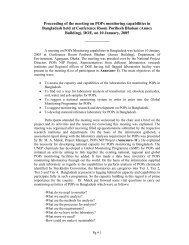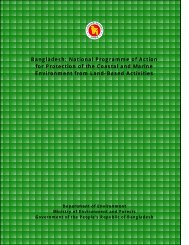Draft CMP HH - the Department of Environment
Draft CMP HH - the Department of Environment
Draft CMP HH - the Department of Environment
Create successful ePaper yourself
Turn your PDF publications into a flip-book with our unique Google optimized e-Paper software.
Coastal and Wetland Biodiversity Management Project BGD/99/G31<br />
Hakaluki Haor <strong>Draft</strong> Conservation Management Plan<br />
• Identify mechanisms to ensure that sanctuaries are established under an appropriate legal<br />
framework which supports biodiversity conservation<br />
• In collaboration with local communities and relevant government agencies, develop suitable<br />
frameworks for effective long-term management <strong>of</strong> <strong>the</strong> sanctuaries<br />
• Prepare agreements involving relevant parties involved in <strong>the</strong> management <strong>of</strong> <strong>the</strong> sanctuaries<br />
• Develop an M&E framework which uses biological indicators to assess <strong>the</strong> effectiveness <strong>of</strong> <strong>the</strong><br />
sanctuaries for biodiversity conservation and more particularly species recovery<br />
Primary Outcome/ Output<br />
• Wildlife sanctuaries are established throughout <strong>the</strong> ECA and managed in collaboration with<br />
local community groups for <strong>the</strong> protection <strong>of</strong> biodiversity especially threatened species<br />
Constraints<br />
• Site selection may conflict with o<strong>the</strong>r intended uses<br />
• Obtaining permission from local land-owners and relevant government agencies may prove slow<br />
and cumbersome<br />
• Communities may not necessarily <strong>the</strong> establishment <strong>of</strong> all proposed wildlife sanctuaries<br />
7.2.4 Swamp Forest Plantations<br />
Not only is <strong>the</strong> assemblage <strong>of</strong> swamp forest species found at Hakaluki Haor unique and highly<br />
specialised to <strong>the</strong> seasonal and prolonged inundation <strong>of</strong> <strong>the</strong> region, but much <strong>of</strong> <strong>the</strong> resident wildlife<br />
<strong>of</strong> <strong>the</strong> area is highly adapted to this original vegetation that was once abundant throughout <strong>the</strong> ECA.<br />
Many birds including <strong>the</strong> Pallas Fish Eagle, Grey-Headed Eagle, and Brahminy Kite choose in<br />
preference swamp forest species such as Hijol (Beringtonia aucutangulata) and Corotch (Pongamia<br />
pinneta) for roosting and nesting; small mammals and reptiles seek refuge and shelter in <strong>the</strong> shrubs,<br />
grasses and reeds which make-up <strong>the</strong> understory <strong>of</strong> <strong>the</strong> swamp forest; and beneath <strong>the</strong> surface <strong>of</strong> <strong>the</strong><br />
water <strong>the</strong> tangle <strong>of</strong> roots, stems, shoots and aquatic plant species creates <strong>the</strong> perfect feeding and<br />
breeding ground for Haor fish.<br />
With swamp forests now mostly non-existent or highly degraded throughout <strong>the</strong> Haor, it is now<br />
imperative that work commences aimed at restoring and regenerating this original vegetative cover<br />
<strong>of</strong> <strong>the</strong> ECA. A significant number <strong>of</strong> important sites where such work can begin have already been<br />
identified and initial work to prioritise <strong>the</strong>se sites has commenced. Fur<strong>the</strong>r research and data<br />
collection is required.<br />
Management Actions<br />
• Raise awareness among local community groups about <strong>the</strong> ecological importance and urgent<br />
need to begin <strong>the</strong> process <strong>of</strong> restoring and regenerating <strong>the</strong> swamp forests <strong>of</strong> Hakaluki Haor<br />
• Continue to survey, identify and prioritise suitable sites for <strong>the</strong> restoration and regeneration <strong>of</strong><br />
swamp forests<br />
• Identify and articulate major rehabilitation and protection requirements and develop a plan for<br />
<strong>the</strong> effective management <strong>of</strong> each site identified. In particular, pay attention to threats and<br />
pressures such as agricultural encroachment, harvesting especially for fuel and building<br />
materials, and cattle grazing<br />
• Conduct fur<strong>the</strong>r research into <strong>the</strong> impacts <strong>of</strong> a specific species <strong>of</strong> sponge which is preventing <strong>the</strong><br />
growth <strong>of</strong> plants such Hijol (Beringtonia aucutangulata) and Corotch (Pongamia pinneta)<br />
Prepared by UNOPS Consultant Mr. Sulma Warne August/ September 2005 for Project BGD/99/G31 22





